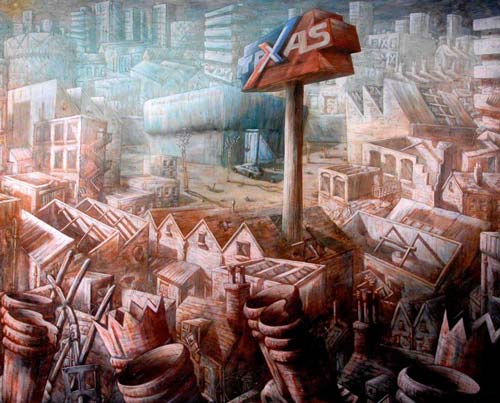
'The Chain Store' © Graham Crowley.
It's the final few days of the
John Moores Painting Prize call for entries and the last weeks of the
REALITY exhibition - so who better to interview than an artist strongly connected to both; Graham Crowley.
Tell us about your history with the Walker and the John Moores Painting Prize…
The
Walker Art Gallery has been instrumental in exhibiting my paintings and has played a major part in my career. My history of exhibiting at the gallery goes back to 1976 when I first showed in the John Moores Painting Prize (
Exhibition 10). Being selected was obviously important – but the reviews of the show, particularly those written by William Feaver of the Observer, were also significant for me. Feaver described my early paintings as;
"...a mix of cubist syntax and a raw, punk aesthetic"
He was one of the first reviewers to realise my paintings were a synthesis of high and low cultural references. Since 1976 I have shown a total of eight times in the John Moores, which has also included my painting ‘No Such Thing’ currently on display in REALITY. In 2008 I was invited to be a juror alongside Paul Morrison, Sacha Craddock and Jake & Dinos Chapman. We made our selections and put together what we felt was a representative, diverse and entertaining exhibition.
What is the story behind your painting ‘The Chain Store’, featured in the

Graham Crowley on the jury for the John Moores in 2008.
REALITY exhibition?
I was living and working in Cardiff in the late 1980s. The docks had been in decline for at least 20 years and had finally closed to freight in the late 1970s. By 1987 the docks were being redeveloped as part of a generic out of town 'park and shop' location along with masses of expensive flats. What had once been one of the largest docks in the UK had become somewhere to shop.
Here was a moment of significant social transformation. What had been an economy of production was becoming an economy of consumption. The docks had become another casualty of globalisation. Where there had been warehouses there were now retail sheds. Big sheds with names like Toys R Us, Texas Homecare and Quick Fit.
In 'The Chain Store' I depict the dilapidated Victorian warehouses briefly co-existing with the vast new sheds and burnt-out abandoned cars. The days of the ironmonger were numbered.
Just as the docks were eclipsed, I believe the days of the retail park are numbered as online shopping takes hold.
What are the main influences on your work at the moment?
I'm fascinated by the Ash Can School. This was an American school of painting that was probably the first urban movement in painting. The painters that were associated with this movement were George Bellows, John Sloan, George Lutz and Stuart Davis. Davis is the most important American painter that no one has ever heard of - particularly in Europe. His career charts the 20th century in both his painting and his politics. He was involved in the socialist journal ‘The Masses’ and was the founding father of Pop Art - almost forty years before Warhol et al.

 'The Chain Store' © Graham Crowley.
It's the final few days of the John Moores Painting Prize call for entries and the last weeks of the REALITY exhibition - so who better to interview than an artist strongly connected to both; Graham Crowley.
'The Chain Store' © Graham Crowley.
It's the final few days of the John Moores Painting Prize call for entries and the last weeks of the REALITY exhibition - so who better to interview than an artist strongly connected to both; Graham Crowley.
 Graham Crowley on the jury for the John Moores in 2008.
Graham Crowley on the jury for the John Moores in 2008.
